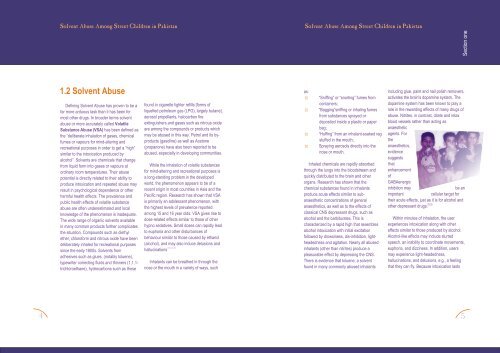solvent-abuse-pakistan
solvent-abuse-pakistan
solvent-abuse-pakistan
You also want an ePaper? Increase the reach of your titles
YUMPU automatically turns print PDFs into web optimized ePapers that Google loves.
Section one<br />
1.2 Solvent Abuse<br />
Defining Solvent Abuse has proven to be a<br />
far more arduous task than it has been for<br />
most other drugs. In broader terms <strong>solvent</strong><br />
<strong>abuse</strong> or more accurately called Volatile<br />
Substance Abuse (VSA) has been defined as<br />
the “deliberate inhalation of gases, chemical<br />
fumes or vapours for mind-altering and<br />
recreational purposes in order to get a “high”<br />
similar to the intoxication produced by<br />
alcohol”. Solvents are chemicals that change<br />
from liquid form into gases or vapours at<br />
ordinary room temperatures. Their <strong>abuse</strong><br />
potential is directly related to their ability to<br />
produce intoxication and repeated <strong>abuse</strong> may<br />
result in psychological dependence or other<br />
harmful health effects. The prevalence and<br />
public health effects of volatile substance<br />
<strong>abuse</strong> are often underestimated and local<br />
knowledge of the phenomenon is inadequate.<br />
The wide range of organic <strong>solvent</strong>s available<br />
in many common products further complicates<br />
the situation. Compounds such as diethyl<br />
ether, chloroform and nitrous oxide have been<br />
deliberately inhaled for recreational purposes<br />
since the early 1800s. Solvents from<br />
adhesives such as glues, (notably toluene),<br />
typewriter correcting fluids and thinners (1,1,1-<br />
trichloroethane), hydrocarbons such as those<br />
found in cigarette lighter refills [forms of<br />
liquefied petroleum gas (LPG), largely butane],<br />
aerosol propellants, halocarbon fire<br />
extinguishers and gases such as nitrous oxide<br />
are among the compounds or products which<br />
may be <strong>abuse</strong>d in this way. Petrol and its byproducts<br />
(gasoline) as well as Acetone<br />
(propanone) have also been reported to be<br />
<strong>abuse</strong>d, especially in developing communities.<br />
While the inhalation of volatile substances<br />
for mind-altering and recreational purposes is<br />
a long-standing problem in the developed<br />
world, the phenomenon appears to be of a<br />
recent origin in most countries in Asia and the<br />
Pacific region. Research has shown that VSA<br />
is primarily an adolescent phenomenon, with<br />
the highest levels of prevalence reported<br />
among 15 and 16 year olds. VSA gives rise to<br />
dose-related effects similar to those of other<br />
hypno sedatives. Small doses can rapidly lead<br />
to euphoria and other disturbances of<br />
behaviour similar to those caused by ethanol<br />
(alcohol), and may also induce delusions and<br />
hallucinations<br />
. 19,20,21,22,23,24.<br />
Inhalants can be breathed in through the<br />
nose or the mouth in a variety of ways, such<br />
as:<br />
<br />
<br />
<br />
<br />
“Sniffing” or “snorting” fumes from<br />
containers;<br />
“Bagging”sniffing or inhaling fumes<br />
from substances sprayed or<br />
deposited inside a plastic or paper<br />
bag;<br />
“Huffing” from an inhalant-soaked rag<br />
stuffed in the mouth;<br />
Spraying aerosols directly into the<br />
nose or mouth.<br />
Inhaled chemicals are rapidly absorbed<br />
through the lungs into the bloodstream and<br />
quickly distributed to the brain and other<br />
organs. Research has shown that the<br />
chemical substances found in inhalants<br />
produce acute effects similar to subanaesthetic<br />
concentrations of general<br />
anaesthetics, as well as to the effects of<br />
classical CNS depressant drugs, such as<br />
alcohol and the barbiturates. This is<br />
characterized by a rapid high that resembles<br />
alcohol intoxication with initial excitation<br />
followed by drowsiness, dis-inhibition, lightheadedness<br />
and agitation. Nearly all <strong>abuse</strong>d<br />
inhalants (other than nitrites) produce a<br />
pleasurable effect by depressing the CNS.<br />
There is evidence that toluene, a <strong>solvent</strong><br />
found in many commonly <strong>abuse</strong>d inhalants<br />
including glue, paint and nail polish removers,<br />
activates the brain's dopamine system. The<br />
dopamine system has been known to play a<br />
role in the rewarding effects of many drugs of<br />
<strong>abuse</strong>. Nitrites, in contrast, dilate and relax<br />
blood vessels rather than acting as<br />
anaesthetic<br />
agents. For<br />
the<br />
anaesthetics,<br />
evidence<br />
suggests<br />
that<br />
enhancement<br />
of<br />
GABAenergic<br />
inhibition may<br />
be an<br />
important<br />
cellular target for<br />
their acute effects, just as it is for alcohol and<br />
25,26<br />
other depressant drugs.<br />
Within minutes of inhalation, the user<br />
experiences intoxication along with other<br />
effects similar to those produced by alcohol.<br />
Alcohol-like effects may include slurred<br />
speech, an inability to coordinate movements,<br />
euphoria, and dizziness. In addition, users<br />
may experience light-headedness,<br />
hallucinations, and delusions, e.g., a feeling<br />
that they can fly. Because intoxication lasts<br />
4<br />
5


